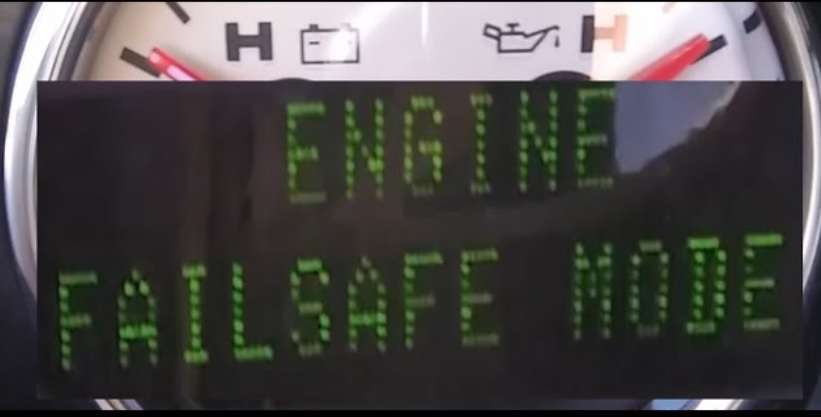Engine Failsafe Mode on the Ford F150 is a mode activated by the computer when a system failure occurs, limiting certain vehicle features and reducing speed to minimize the risk of further damage.
Understanding Engine Failsafe Mode
Engine Failsafe Mode is an important feature in modern vehicles that activates when the computer detects a system failure.
When a failure happens, the computer initiates failsafe mode to reduce the risk the failure poses to your car and its occupants.
In this mode, some vehicle features are limited, and the car’s speed is reduced to prevent further damage.
Definition And Purpose Of Engine Failsafe Mode
Engine Failsafe Mode is activated by the computer when it has lost crucial input information or the ability to control certain outputs related to the engine or transmission.
Its purpose is to allow you to drive the vehicle to your destination safely while prompting you to get the necessary repairs as soon as possible.
How Engine Failsafe Mode Works
When a sensor or engine device detects a failure, a code is stored in the computer. This code triggers Engine Failsafe Mode, limiting vehicle features and speed.
It is important to read your vehicle’s owner’s manual to understand the specific limitations and warning signals associated with the failsafe mode.
Explanation Of The Warning Signals
When Engine Failsafe Mode is activated, warning signals such as dashboard lights or messages may appear.
These warning signals indicate that the vehicle is in failsafe mode and prompt you to take necessary action, such as getting the vehicle inspected by a professional.
It is important to address the underlying issue to prevent further damage and ensure the safe operation of your vehicle.
Causes Of Engine Failsafe Mode
Sensor faults and their impact on Engine Failsafe Mode: When a sensor in the engine detects a failure or fault, it triggers the Engine Failsafe Mode.
This mode is activated by the computer in an attempt to prevent further damage to the engine.
Some examples of sensor faults that can lead to Engine Failsafe Mode include a faulty throttle position sensor, oxygen sensor, or mass airflow sensor.
ECU faults and their impact on Engine Failsafe Mode: The Engine Control Unit (ECU) is responsible for managing the engine’s performance and emissions.
If the ECU malfunctions or detects an issue with the engine, it can activate the Engine Failsafe Mode.
This can occur due to a faulty ECU or a communication problem between the ECU and other engine components.
When the engine enters Failsafe Mode, the vehicle’s features may become limited, and the speed of the car is reduced.
It is important to address the underlying issue and get the vehicle in for repairs as soon as possible to avoid further damage.
Troubleshooting Engine Failsafe Mode
When experiencing Engine Failsafe Mode on your Ford F150, there are a few steps you can take to troubleshoot the issue.
First, it is important to reset the Engine Failsafe Mode. To do this, you can try disconnecting the battery for a few minutes and then reconnecting it. This may reset the system and clear any fault codes.
If the issue persists, it is recommended to check for common issues that can lead to Engine Failsafe Mode. Some possible causes include a faulty sensor or an ECU fault.
Additionally, a high temperature in the engine can trigger failsafe mode. It is advisable to check the battery voltage as a low battery can also cause Engine Failsafe Mode.
In conclusion, Engine Failsafe Mode is a safety feature activated by the computer when it detects a system failure.
While it may limit some vehicle features and reduce speed, it is generally safe to drive in failsafe mode and reach your destination to get the necessary repairs.

Engine Failsafe Mode on Ford F150
Frequently Asked Questions For What Is Engine Failsafe Mode On Ford F150?
What Does Engine Fail Safe Mode Mean?
In fail-safe mode, the car’s computer activates when a system failure occurs. This limits certain features and reduces speed to minimize risk. It is safe to drive, but repairs should be made as soon as possible. A bad battery can sometimes trigger fail-safe mode.
Check battery voltage for potential causes.
How Do I Reset My Engine Failsafe Mode?
To reset your engine failsafe mode, follow these steps:
1. Turn off the engine and wait for 10 minutes.
2. Disconnect the negative terminal of your car battery.
3. Reconnect the negative terminal of the battery.
4. Start your car and let it run for a few minutes.
5. Drive your car normally, and the engine failsafe mode should be reset. Make sure to check your vehicle’s manual for specific instructions for your make and model.
Is It Safe To Drive In Fail-Safe Mode?
Yes, it is safe to drive in fail-safe mode. Fail-safe mode is activated when the computer detects a system failure, and it limits certain vehicle features and reduces speed to minimize the risk. It is designed to get you to your destination and prompt repairs.
Can A Bad Battery Cause Engine Failsafe Mode?
Yes, a bad battery can cause the engine failsafe mode. This is because low voltage from a bad battery can cause the computer to lose crucial input information, triggering failsafe mode.
Why Does My Ford F150 Go Into Engine Failsafe Mode?
The Engine Failsafe Mode is activated when the computer detects a system failure or sensor out of tolerance, reducing risk to the car and limiting features.
Conclusion
Engine failsafe mode on a Ford F150 is activated by the computer when a system failure occurs and certain features of the vehicle become limited.
This mode is designed to reduce the risk of further damage by restricting the speed and capabilities of the car.
It is important to address the underlying issue and seek repairs as soon as possible.
Remember, this mode is temporary and meant to get you safely to your destination.







